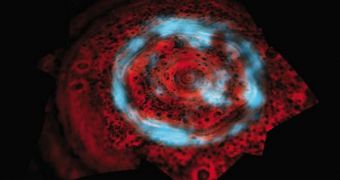Until not many years ago, astronomers believed that auroras only form on our planet, from the interaction of solar winds with Earth's magnetic lines. With the advent of modern telescope technology, it became possible to construct devices that proved this to be false. It was shown that most planets which have magnetic field lines and atmospheres can form these peculiar lights, which have puzzled and inspired so many here. Just recently, the Cassini spacecraft has sent back a new set of recordings of Saturn's auroras, which had been revealed before, but not in so much detail, Space reports.
In the gas giant's case, the formation mechanism for these shimmering lights is mostly the same as that seen here on our planet. The magnetic fields looming overhead interact with chemicals in the planet's atmosphere, forcing it to produce the auroras. While on Earth they occur closer to the ground, in our distant neighbor's case they usually form about 750 miles (1,200 km) above the surface. This sets Saturn on the first place in the top of highest ever auroras in the solar system, astronomers say.
“The auroras have put on a dazzling show, shape-shifting rapidly and exposing curtains that we suspected were there, but hadn't seen on Saturn before. Seeing these things on another planet helps us understand them a little better when we see them on Earth,” explains California Institute of Technology (Caltech) scientist Andrew Ingersoll, speaking about the new Cassini videos. The lights were also found to occur most often and strongest above the planet's magnetic surface, a finding that is consistent to the model which explains how auroras form regardless of their location in the solar system.
One of the main reasons why the shimmering lights occur so far away from the surface of Saturn is the fact that the planet's atmosphere is composed primarily out of hydrogen, whereas ours also has massive amounts of nitrogen and oxygen. This means that our neighboring gas giant has a lighter atmosphere, which allows for the aurora-triggering interactions to take place at higher altitudes. On our planet, they cause the lights to appear just 60 to 300 miles (100 to 500 km) above the surface.
“I was wowed when I saw these images and the curtain. Put this together with the other data Cassini has collected on the auroras so far, and you really get a new science,” adds University of Michigan in Ann Arbor expert Tamas Gombosi. The images in the movie are black and white, but the research team managed to color the auroras artificially, in false-color orange. The video can be viewed here.

 14 DAY TRIAL //
14 DAY TRIAL //